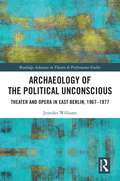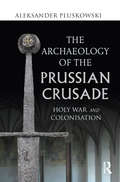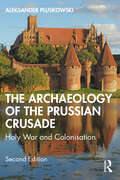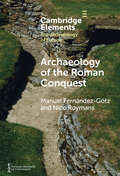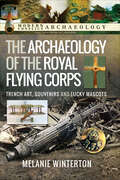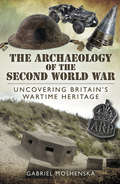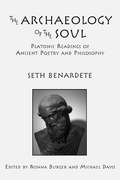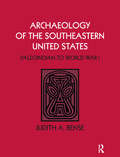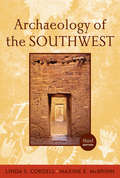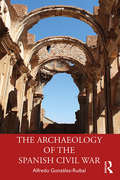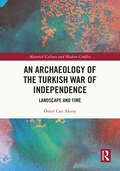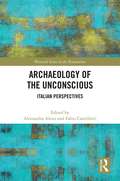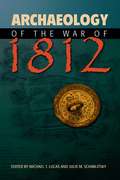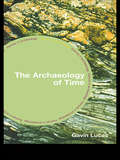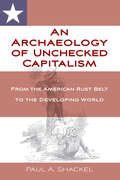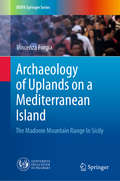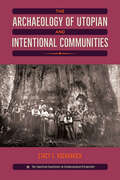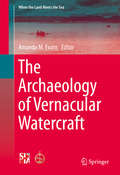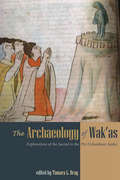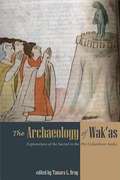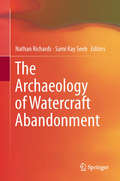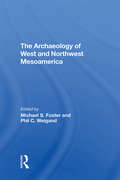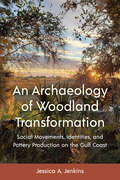- Table View
- List View
Archaeology of the Political Unconscious: Theater and Opera in East Berlin, 1967–1977 (ISSN)
by Jennifer WilliamsThis book investigates the aesthetic and political dialectics of East Berlin to argue how its theater and opera stages incited artists to act out, fuel, and resist the troubled construction of political legitimacy.This volume investigates three case studies of how leading East Berlin stages excavated fragmentary materials from Weimar dramatist Bertolt Brecht’s oeuvre and repurposed them for their post‑fascist society: Uta Birnbaum’s 1967 Man Equals Man at the Berliner Ensemble, Joachim Herz’s 1977 Rise and Fall of the City of Mahagonny at the Komische Oper, and Heiner Muller’s own productions of his trailblazing plays. In each instance, reused theatrical artifacts dialectically expressed the contradictions inherent in East German political legitimacy, at once amplifying and critiquing it. Illuminated by original archival research and translations of letters and artistic ephemera published in English for the first time, and engaging with alternative East German feminist epistemologies, this book’s critical investigation of culture and political legitimacy in the shadow of Germany’s fascist past resonates beyond the Iron Curtain into the twenty‑first century. Its final chapter examines how performative artifacts influence the process of political legitimation in more recent history, ranging from Checkpoint Charlie tourism to the January 6, 2021 US insurrection.This study will be of great interest to students and scholars in theater and performance studies, art history, musicology, German studies, anthropology, and political science.
The Archaeology of the Prussian Crusade: Holy War and Colonisation
by Aleksander PluskowskiThe Archaeology of the Prussian Crusade explores the archaeology and material culture of the crusade against the Prussian tribes in the 13th century, and the subsequent society created by the Teutonic Order which lasted into the 16th century. It provides the first synthesis of the material culture of a unique crusading society created in the south-eastern Baltic region over the course of the 13th century. It encompasses the full range of archaeological data, from standing buildings through to artefacts and ecofacts, integrated with written and artistic sources. The work is sub-divided into broadly chronological themes, beginning with a historical outline, exploring the settlements, castles, towns and landscapes of the Teutonic Order’s theocratic state and concluding with the role of the reconstructed and ruined monuments of medieval Prussia in the modern world in the context of modern Polish culture. This is the first work on the archaeology of medieval Prussia in any language, and is intended as a comprehensive introduction to a period and area of growing interest. This book represents an important contribution to promoting International awareness of the cultural heritage of the Baltic region, which has been rapidly increasing over the last few decades.
The Archaeology of the Prussian Crusade: Holy War and Colonisation
by Aleksander PluskowskiThe Archaeology of the Prussian Crusade explores the archaeology and material culture of the crusades against the Prussian tribes in the 13th century, and the resulting society created by the Teutonic Order which endured into the 16th century. It provides an updated synthesis of the material culture of this unique, hybrid society in the south-eastern Baltic region, encompassing the full range of archaeological data, from standing buildings through to artefacts and ecofacts, integrated with written and artistic sources. The work is sub-divided into broadly chronological themes, beginning with a historical outline, then exploring the settlements, castles, towns and landscapes of the Teutonic Order’s theocratic state, the character and tempo of religious transformation and concluding with the roles of the reconstructed and ruined monuments of medieval Prussia in the modern world, particularly within the context of Polish culture. This remains the first work on the archaeology of medieval Prussia in any language, and is intended as a comprehensive introduction to a period and area of growing interest. This book represents an important contribution to promoting International awareness of the cultural heritage of the Baltic region, which has been rapidly increasing over the last few decades.
Archaeology of the Roman Conquest: Tracing the Legions, Reclaiming the Conquered (Elements in the Archaeology of Europe)
by Manuel Fernández-Götz Nico RoymansThis Element volume provides an up-to-date synthesis of the archaeology of the Roman conquest, combining new theoretical and methodological approaches with the latest fieldwork results. Recent advances in conflict archaeology research are revolutionising our knowledge of Rome's military campaigns in Western and Central Europe, allowing scholars to reassess the impact of the conquest on the indigenous populations. The volume explores different types of material evidence for the Roman wars of conquest, including temporary camps, battlefields, coinage production, and regional settlement patterns. These and other topics are examined using four case studies: Caesar's Gallic Wars, the Cantabrian and Asturian Wars, the Germanic Wars of Augustus, and the Roman conquest of Britain. By focusing on the 'dark sides' of the Roman expansion and reclaiming the memory of the conquered, the Element aims to contribute to a more holistic understanding of the processes of incorporation and integration into the Roman Empire.
The Archaeology of the Royal Flying Corps: Trench Art, Souvenirs and Lucky Mascots (Modern Conflict Archaeology)
by Melanie Winterton"Winterton’s book is a good introductory effort on the haptic environment of World War I aviators and their personal artifacts."—The Journal of the Air Force Historical FoundationArchaeology provides a fascinating insight into the lives of the aviators of the First World War. Their descriptions of the sensation of flying in the open cockpits of the primitive warplanes of the day, and the artifacts that have survived from these first years of aerial combat, give us a powerful sense of what their wartime service was like and chart the beginning of our modern understanding of aviation. But the subject hasn’t been explored in any depth before, which is why Melanie Winterton’s pioneering book is so timely. Hers is the first study of the trench art, souvenirs and lucky mascots associated with the Royal Flying Corps which, in an original way, tell us so much about the experience of flying on the Western Front a century ago. Extensive quotations from the memoirs of these early airmen are combined with an analysis of the artifacts themselves. They convey something of the fear and anxiety the airmen had to grapple with on a daily basis and bring out the full significance of the poignant souvenirs they left behind. Pieces of crashed aeroplane – wooden propellers, strips of linen, fragments of metal – were recycled and circulated during the war and afterwards became the focus of attention in the domestic home. As Melanie Winterton demonstrates, these items connected the living with the deceased, which is why they are so strongly evocative even today.
The Archaeology of the Second World War: Uncovering Britain's Wartime Heritage
by Gabriel MoshenskaThe Second World War transformed British society. Men, women and children inhabited the war in every area of their lives, from their clothing and food to schools, workplaces and wartime service. This transformation affected the landscapes, towns and cities as factories turned to war work, beaches were prepared as battlefields and agricultural land became airfields and army camps. Some of these changes were violent: houses were blasted into bombsites, burning aircraft tumbled out of the sky and the seas around Britain became a graveyard for sunken ships. Many physical signs of the war have survived a vast array of sites and artefacts that archaeologists can explore - and Gabriel Moshenskas new book is an essential introduction to them. He shows how archaeology can bring the ruins, relics and historic sites of the war to life, especially when it is combined with interviews and archival research in order to build up a clear picture of Britain and its people during the conflict. His work provides for the first time a broad and inclusive overview of the main themes of Second World War archaeology and a guide to many of the different types of sites in Britain. It will open up the subject for readers who have a general interest in the war and it will be necessary reading and reference for those who are already fascinated by wartime archaeology - they will find something new and unexpected within the wide range of sites featured in the book.
An Archaeology of the Soul: North American Indian Belief and Ritual
by Robert L. HallThis book describes North American Indian beliefs and rituals. It also includes bibliographical references and an index.
The Archaeology of the Soul: Platonic Readings of Ancient Poetry and Philosophy
by Seth Benardete; Ronna Burger; Michael DavisAt the same time that he was pursuing a track backward, from Plato to the poets and pre-Socratic philosophers, Benardete was also proceeding on a forward path, from Plato to the Latin writers, who adopt the Platonic way of thinking with full understanding of what it means to be "post-Platonic."
Archaeology of the Southeastern United States: Paleoindian to World War I
by Judith A BenseA chronological summary of major stages in Southeastern United States' development, this unique textbook overviews the region's archaeology from 20,000 years ago to World War I. Early chapters review the history and development of archaeology as a discipline. The following chapters, organized in chronological order, highlight the archaeological characteristics of each featured period. The book's final chapters discuss new directions in Southeastern archaeology, including trends in teaching, research, the business of archaeology, and the public's growing interest. This versatile text perfectly suits undergraduates or anyone requiring a hands-on guide for self-exploration of the fascinating region. This is the first-of-its kind book to summarize Southeastern archaeology. It includes both prehistoric and historic archaeology. Its easy-to-read format is filled with valuable research information. Each chapter is chronologically organized and fully referenced. It has broad audience appeal.
Archaeology of the Southwest: Contact, Commerce, And Change In The U. S. Southwest And Northwestern Mexico (Proceedings Of Sw Symposium Ser.)
by Linda S Cordell Maxine McBrinnThe long-awaited third edition of this well-known textbook continues to be the go-to text and reference for anyone interested in Southwest archaeology. It provides a comprehensive summary of the major themes and topics central to modern interpretation and practice. More concise, accessible, and student-friendly, the Third Edition offers students the latest in current research, debates, and topical syntheses as well as increased coverage of Paleoindian and Archaic periods and the Casas Grandes phenomenon. It remains the perfect text for courses on Southwest archaeology at the advanced undergraduate and graduate levels and is an ideal resource book for the Southwest researchers’ bookshelf and for interested general readers.
The Archaeology of the Spanish Civil War
by Alfredo González-RuibalThe Archaeology of the Spanish Civil War offers the first comprehensive account of the Spanish Civil War from an archaeological perspective, providing an alternative narrative on one of the most important conflicts of the twentieth century, widely seen as a prelude to the Second World War. <p><P>Between 1936 and 1939, totalitarianism and democracy, fascism and revolution clashed in Spain, while the latest military technologies were being tested, including strategic bombing and combined arms warfare, and violence against civilians became widespread. Archaeology, however, complicates the picture as it brings forgotten actors into play: obsolete weapons, vernacular architecture, ancient structures (from Iron Age hillforts to sheepfolds), peasant traditions, and makeshift arms. By looking at these things, another story of the war unfolds, one that pays more attention to intimate experiences and anonymous individuals. Archaeology also helps to clarify battles, which were often chaotic and only partially documented, and to understand better the patterns of political violence, whose effects were literally buried for over 70 years. The narrative starts with the coup against the Second Spanish Republic on 18 July 1936, follows the massacres and battles that marked the path of the war, and ends in the early 1950s, when the last forced labor camps were closed and the anti-Francoist guerrillas suppressed. <p><P>The book draws on 20 years of research to bring together perspectives from battlefield archaeology, archaeologies of internment, and forensics. It will be of interest to anybody interested in historical and contemporary archaeology, human rights violations, modern military history, and negative heritage.
An Archaeology of the Turkish War of Independence: Landscape and Time (Material Culture and Modern Conflict)
by Ömer Can AksoyThis book is about the conflict which resolved the Greek–Turkish War of 1919–1922: the Great Offensive. On 26 August 1922, the army of the GNA executed the Great Offensive against the Greek defence line extending from the Bay of Gemlik to the Meander River. The Turkish Forces split the Greek Army into two large groups, annihilated one of the groups in the field at the Battle of Dumlupınar on 30 August and pursued the remaining forces of the Greek Army towards the Aegean and Marmara coasts until 18 September. Within these 24 days, the face of Western Anatolia changed unalterably: numerous towns, villages and cities of Western Anatolia were reduced to ashes. This conflict was a turning point in the histories of Turkey and Greece, as it played a significant role in shaping the present-day demographic and geopolitical landscapes of both nations. It resulted in a population exchange in 1923 that dramatically altered the lives of Muslims in Greece and Greek Orthodox people in Turkey and paved the way to the foundation of the Republic of Turkey. Despite the outcome of this war and the existence of a rich literature on its military and political history, the landscapes, memoryscapes and material culture have not been systematically investigated. This book bridges that gap via an archaeological, historical and oral-historical study of the Great Offensive and its aftermath. With its wide chronological perspective, this book is not a pure analysis of a historical war, it is instead a journey into the foundation myth of the Turkish Republic and the ideological foundations of the Turkish state.
Archaeology of the Unconscious: Italian Perspectives (Warwick Series in the Humanities)
by Alessandra Aloisi Fabio CamillettiIn reconstructing the birth and development of the notion of ‘unconscious’, historians of ideas have heavily relied on the Freudian concept of Unbewussten, retroactively projecting the psychoanalytic unconscious over a constellation of diverse cultural experiences taking place in the eighteenth and nineteenth centuries between France and Germany. Archaeology of the Unconscious aims to challenge this perspective by adopting an unusual and thought-provoking viewpoint as the one offered by the Italian case from the 1770s to the immediate aftermath of WWI, when Italo Svevo’s La coscienza di Zeno provides Italy with the first example of a ‘psychoanalytic novel’. Italy’s vibrant culture of the long nineteenth century, characterised by the sedimentation, circulation, intersection, and synergy of different cultural, philosophical, and literary traditions, proves itself to be a privileged object of inquiry for an archaeological study of the unconscious; a study whose object is not the alleged ‘origin’ of a pre-made theoretical construct, but rather the stratifications by which that specific construct was assembled. In line with Michel Foucault’s Archéologie du savoir (1969), this volume will analyze the formation and the circulation, across different authors and texts, of a network of ideas and discourses on interconnected themes, including dreams, memory, recollection, desire, imagination, fantasy, madness, creativity, inspiration, magnetism, and somnambulism. Alongside questioning pre-given narratives of the ‘history of the unconscious’, this book will employ the Italian ‘difference’ as a powerful perspective from whence to address the undeveloped potentialities of the pre-Freudian unconscious, beyond uniquely psychoanalytical viewpoints.
Archaeology of the War of 1812
by Michael T. Lucas Julie M. SchablitskyThis is the first summary of how archaeology has contributed to our understanding of the War of 1812. The contributors of original papers discuss recent excavations and field surveys that present an archaeological perspective that enriches,—and often conflicts with, received historical narratives. The studies cover fortifications, encampments, landscapes, shipwrecks, and battles in the midwestern, southern, mid-atlantic, and northeastern regions of the United States and in Canada. In addition to archaeologists, this volume will appeal to military history specialists and other historians.
The Archaeology of Time (Themes in Archaeology Series)
by Gavin LucasIt might seem obvious that time lies at the heart of archaeology, since archaeology is about the past. However, the issue of time is complicated and often problematic, and although we take it very much for granted, our understanding of time affects the way we do archaeology.This book is an introduction not just to the issues of chronology and dating, but time as a theoretical concept and how this is understood and employed in contemporary archaeology. It provides a full discussion of chronology and change, time and the nature of the archaeological record, and the perception of time and history in past societies. Drawing on a wide range of archaeological examples from a variety of regions and periods, The Archaeology of Time provides students with a crucial source book on one of the key themes of archaeology.
An Archaeology of Unchecked Capitalism: From the American Rust Belt to the Developing World
by Paul ShackelThe racialization of immigrant labor and the labor strife in the coal and textile communities in northeastern Pennsylvania appears to be an isolated incident in history. Rather this history can serve as a touchstone, connecting the history of the exploited laborers to today’s labor in the global economy. By drawing parallels between the past and present – for example, the coal mines of the nineteenth-century northeastern Pennsylvania and the sweatshops of the twenty-first century in Bangladesh – we can have difficult conversations about the past and advance our commitment to address social justice issues.
Archaeology of Uplands on a Mediterranean Island: The Madonie Mountain Range In Sicily (UNIPA Springer Series)
by Vincenza ForgiaThis book presents archaeological research conducted within the Highlands of Sicily. Results of an archaeological survey in the Madonie mountain range, in northern Sicily, supported by a chronological and cultural grid, drawn by the excavation of Vallone Inferno, deal with complex and fascinating problems of uplands and mountainous landscape. Settlement patterns, between the Late Pleistocene and the Medieval era, are investigated through the support of spatial analyses. A diversified use of the mountain is currently attested by this research, according to the different prehistoric and historical times. This work is innovative for the Mediterranean area, where there are no similar examples of such extensive territorial research in a mountainous context. The research has been focused on particular aspects of ancient peopling: economic and social issues, human-environment interactions and the long term interest in the mountain range.
The Archaeology of Urbanism in Ancient Egypt
by Nadine MoellerIn this book, Nadine Moeller challenges prevailing views on Egypt's non-urban past and argues for Egypt as an early urban society. She traces the emergence of urban features during the Predynastic Period up to the disintegration of the powerful Middle Kingdom state (ca. 3500-1650 BC). This book offers a synthesis of the archaeological data that sheds light on the different facets of urbanism in ancient Egypt. Drawing on evidence from recent excavations as well as a vast body of archaeological data, this book explores the changing settlement patterns by contrasting periods of strong political control against those of decentralization. It also discusses households and the layout of domestic architecture, which are key elements for understanding how society functioned and evolved over time. Moeller reveals what settlement patterns can tell us about the formation of complex society and the role of the state in urban development in ancient Egypt.
The Archaeology of Utopian and Intentional Communities (American Experience in Archaeological Pe)
by Stacy C. KozakavichReconstructing the past of intentional communities from across the United StatesUtopian and intentional communities have dotted the American landscape since the colonial era, yet only in recent decades have archaeologists begun analyzing the material culture left behind by these groups. This volume includes discussions of the Shakers, the Harmony Society, the Moravians, the Oneida community, Brook Farm, and Mormon towns. Also featured is an expanded case study of California's late nineteenth-century Kaweah Colony, offering a new perspective on approaches to the study of utopian societies.Surveys of settlement patterns, the built environment, and even the smallest artifacts such as tobacco pipes and buttons are used to uncover what daily life was like in these communities. Archaeological evidence reveals how these communities upheld their societal ideals. Shakers, for example, constructed homes with separate living quarters for men and women, reflecting the group's commitment to celibacy. On the other hand, some communities diverged from their principles, as evidenced by the presence of a key and coins found at Kaweah, indicating private property and a cash economy despite claims to communal and egalitarian practices.Stacy Kozakavich argues archaeology has much to offer in the reconstruction and interpretation of community pasts for the public. Material evidence provides information about these communities free from the underlying assumptions, positive or negative, that characterize past interpretations. She urges researchers not to dismiss these communal experiments as quaint failures but to question how the lifestyles of the people in these groups are interpreted for visitors today. She reminds us that there is inspiration to be found in the unique ways these intentional communities pursued radical social goals.
The Archaeology of Vernacular Watercraft
by Amanda M. EvansThis volume presents multiple idiographic, archaeological studies of vernacular watercraft from North America and the Caribbean. Rather than attempt to synthesize all vernacular types, this volume focuses on ship construction data recovered through archaeological investigations that has been used to make inferences about culture. This collection of case studies, including many examples from cultural resource management and graduate student theses, presents a thematic exploration of cultural adaptation as expressed through ship construction.
The Archaeology of Wak'as: Explorations of the Sacred in the Pre-Columbian Andes
by Tamara L. BrayIn this edited volume, Andean wak'as—idols, statues, sacred places, images, and oratories—play a central role in understanding Andean social philosophies, cosmologies, materialities, temporalities, and constructions of personhood. Top Andean scholars from a variety of disciplines cross regional, theoretical, and material boundaries in their chapters, offering innovative methods and theoretical frameworks for interpreting the cultural particulars of Andean ontologies and notions of the sacred. Wak'as were understood as agentive, nonhuman persons within many Andean communities and were fundamental to conceptions of place, alimentation, fertility, identity, and memory and the political construction of ecology and life cycles. The ethnohistoric record indicates that wak'as were thought to speak, hear, and communicate, both among themselves and with humans. In their capacity as nonhuman persons, they shared familial relations with members of the community, for instance, young women were wed to local wak'as made of stone and wak'as had sons and daughters who were identified as the mummified remains of the community's revered ancestors. Integrating linguistic, ethnohistoric, ethnographic, and archaeological data, The Archaeology of Wak'as advances our understanding of the nature and culture of wak'as and contributes to the larger theoretical discussions on the meaning and role of–"the sacred” in ancient contexts.
Archaeology of Wak'as
by Tamara L. BrayIn this edited volume, Andean wak'as--idols, statues, sacred places, images, and oratories--play a central role in understanding Andean social philosophies, cosmologies, materialities, temporalities, and constructions of personhood. Top Andean scholars from a variety of disciplines cross regional, theoretical, and material boundaries in their chapters, offering innovative methods and theoretical frameworks for interpreting the cultural particulars of Andean ontologies and notions of the sacred.Wak'as were understood as agentive, nonhuman persons within many Andean communities and were fundamental to conceptions of place, alimentation, fertility, identity, and memory and the political construction of ecology and life cycles. The ethnohistoric record indicates that wak'as were thought to speak, hear, and communicate, both among themselves and with humans. In their capacity as nonhuman persons, they shared familial relations with members of the community, for instance, young women were wed to local wak'as made of stone and wak'as had sons and daughters who were identified as the mummified remains of the community's revered ancestors.Integrating linguistic, ethnohistoric, ethnographic, and archaeological data, The Archaeology of Wak'as advances our understanding of the nature and culture of wak'as and contributes to the larger theoretical discussions on the meaning and role of-"the sacred" in ancient contexts.
The Archaeology of Watercraft Abandonment
by Nathan Richards Sami Kay SeebThe historical importance and archaeological potential of deliberately discarded watercraft has not been a major feature of maritime archaeological enquiry. While research on the topic has appeared since the 1970s as books, chapters, and articles, most examples have been limited in focus and distribution, and in most cases disseminated as unpublished archaeological reports (i.e. the "gray literature".) So, too, has there been a lack of a single source representing the diversity of geographical, historic, thematic, and theoretical contexts that ships' graveyard sites and deliberately abandoned vessels represent. In contrast with much of the theoretical or case-specific literature on the theme of watercraft discard, this volume communicates to the reader the common heritage and global themes that ships' graveyard sites represent. It serves as a blueprint to illustrate how the remains of abandoned vessels in ships' graveyards are sites of considerable research value. Moreover, the case studies in this volume assist researchers in understanding the evolution of maritime technologies, economies, and societies. This volume is intended to expose research potential, create discussion, and reinforce the significance of a prevalent cultural resource that is often overlooked.
The Archaeology Of West And Northwest Mesoamerica: The Archaeology Of West And Northwest Mexico
by Michael S Foster Phil C Weigand Leticia Gonzalez Eric W RitterBased on recent archaeological surveys and excavations, the chapters in this volume provide current, comprehensive, area-by-area summaries of the region's Precolumbian past. Research in the last two decades has indicated that the evolution and adaptations of the indigenous cultures of the region parallel those found elsewhere in Mesoamerica, from the simple Formative groups to the complex states of the North. The topics discussed in the book--areal and cultural syntheses and specific problems such as chronology, social organization, and economic systems--present much new information crucial to the understanding of cultural variations in Mesoamerica.
An Archaeology of Woodland Transformation: Social Movements, Identities, and Pottery Production on the Gulf Coast (Florida Museum of Natural History: Ripley P. Bullen Series)
by Jessica A. JenkinsExploring a period of transformative change for the Woodland-era societies of Florida’s Lower Suwannee region In this book, Jessica Jenkins provides a detailed look at the transition from the Middle to Late Woodland periods in the Lower Suwannee region of Florida’s Gulf Coast. Drawing on ceramic analysis techniques, Jenkins argues that this time of transformative change, often interpreted as a societal collapse, instead should be seen as a purposeful shift brought about by emerging social movements. Beginning around 650 CE, the region’s Indigenous inhabitants dispersed from civic-ceremonial centers, moved away from places associated with the dead, changed their burial practices, and adopted new pottery surface treatments and designs. Examining ceramic vessels from 12 sites located on islands near the present-day town of Cedar Key, Jenkins catalogs these shifts. Jenkins explores how people shared social identities that connected them through relational networks and laid the foundation for these changes. An Archaeology of Woodland Transformation is the first book to synthesize information on the villages, networks, and identities of this time and place. Offering rich datasets and new perspectives on sociocultural transformation in and around the lower Suwannee River Estuary, this book represents a breakthrough in current understandings of the Woodland period. A volume in the Florida Museum of Natural History: Ripley P. Bullen Series
